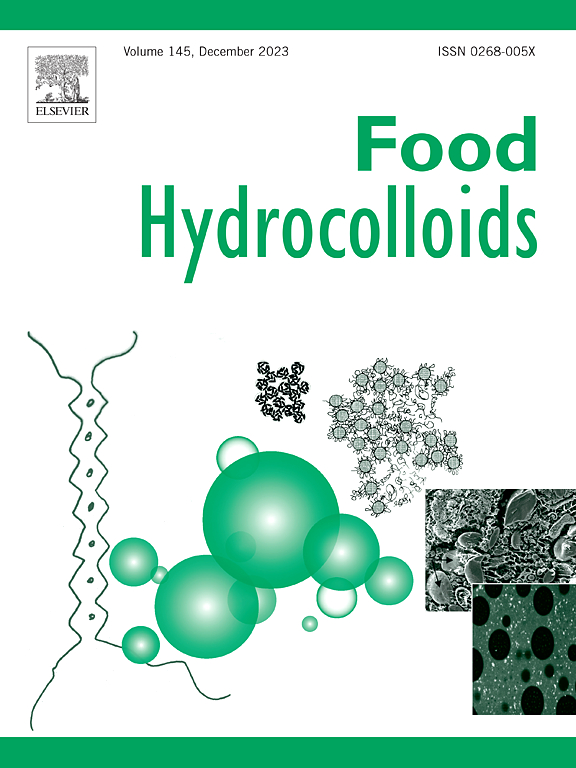Amyloid fibrillation of different ratios of 7S/11S soy protein: comparison of fibril structural characteristics and analysis of the potential for preparing high-internal-phase emulsions
IF 11
1区 农林科学
Q1 CHEMISTRY, APPLIED
引用次数: 0
Abstract
Amyloid fibrils from soybean 7S and 11S proteins can improve emulsion stability by creating a bridge-like structure at the oil-water interface. To clarify the structural features and potential for stabilising high-internal-phase emulsions of 7S/11S protein amyloid fibrils in varying proportions, more investigation is necessary. This study examined the properties of various emulsion types with oil contents of 30 % and 85 %, as well as the characteristics of amyloid fibrils of different proportions of 7S/11S soybean protein (1:0, 0:1, 1:1, 2:1, and 1:2). The 7S/11S ratio of 2:1 had the highest fibrils β-sheet content (51.40 %), the highest ThT fluorescence intensity and the strongest fibrils-forming ability. After amyloid fibrillation treatment, emulsions made with different amounts of 7S/11S soy protein showed improved stability compared to the control group. Additionally, amyloid fibrils consisting of 85 % of oil emulsion had superior characteristics than those of 30 %. The emulsion's EAI and ESI initially increased and subsequently decreased as 7S percentage increased. When the 7S/11S soybean protein ratio was 2:1, the emulsion had the highest viscoelasticity, EAI (89.72 m2/g) and ESI (78.96 min) were the highest, and the smallest particle size (90.9 nm) and lowest TSI values, indicating that the 7S/11S soybean protein amyloid fibrils have excellent potential for preparing high-internal-phase emulsion. This study offers a theoretical foundation for employing soy protein in high internal phase emulsions and for comprehending the structure of the various 7S and 11S protein components from soy amyloid fibrils.

7S/11S大豆蛋白不同比例淀粉样蛋白纤维结构特征比较及制备高内相乳剂的潜力分析
来自大豆7S和11S蛋白的淀粉样原纤维可以通过在油水界面形成桥状结构来提高乳液的稳定性。为了阐明不同比例的7S/11S蛋白淀粉样原纤维的结构特征和稳定高内相乳剂的潜力,需要进行更多的研究。本研究考察了含油量为30%和85%的各种乳化液的性能,以及7S/11S大豆蛋白不同比例(1:0、0:1、1:1、2:1、1:2)的淀粉样原纤维的特性。7S/11S比例为2:1时,原纤维β片含量最高(51.40%),ThT荧光强度最高,形成原纤维的能力最强。淀粉样蛋白颤动治疗后,与对照组相比,加入不同量的7S/11S大豆蛋白制成的乳剂的稳定性有所提高。此外,淀粉样原纤维含量为85%的油乳比30%的油乳具有更好的特性。随着7S百分比的增加,乳液的EAI和ESI先升高后降低。当7S/11S大豆蛋白比为2:1时,乳液的粘弹性最高,EAI (89.72 m2/g)和ESI (78.96 min)最高,粒径最小(90.9 nm), TSI最低,表明7S/11S大豆蛋白淀粉样原纤维具有良好的制备高内相乳液的潜力。本研究为大豆蛋白在高内相乳剂中的应用以及了解大豆淀粉样原纤维中各种7S和11S蛋白组分的结构提供了理论基础。
本文章由计算机程序翻译,如有差异,请以英文原文为准。
求助全文
约1分钟内获得全文
求助全文
来源期刊

Food Hydrocolloids
工程技术-食品科技
CiteScore
19.90
自引率
14.00%
发文量
871
审稿时长
37 days
期刊介绍:
Food Hydrocolloids publishes original and innovative research focused on the characterization, functional properties, and applications of hydrocolloid materials used in food products. These hydrocolloids, defined as polysaccharides and proteins of commercial importance, are added to control aspects such as texture, stability, rheology, and sensory properties. The research's primary emphasis should be on the hydrocolloids themselves, with thorough descriptions of their source, nature, and physicochemical characteristics. Manuscripts are expected to clearly outline specific aims and objectives, include a fundamental discussion of research findings at the molecular level, and address the significance of the results. Studies on hydrocolloids in complex formulations should concentrate on their overall properties and mechanisms of action, while simple formulation development studies may not be considered for publication.
The main areas of interest are:
-Chemical and physicochemical characterisation
Thermal properties including glass transitions and conformational changes-
Rheological properties including viscosity, viscoelastic properties and gelation behaviour-
The influence on organoleptic properties-
Interfacial properties including stabilisation of dispersions, emulsions and foams-
Film forming properties with application to edible films and active packaging-
Encapsulation and controlled release of active compounds-
The influence on health including their role as dietary fibre-
Manipulation of hydrocolloid structure and functionality through chemical, biochemical and physical processes-
New hydrocolloids and hydrocolloid sources of commercial potential.
The Journal also publishes Review articles that provide an overview of the latest developments in topics of specific interest to researchers in this field of activity.
 求助内容:
求助内容: 应助结果提醒方式:
应助结果提醒方式:


